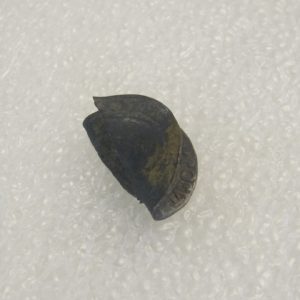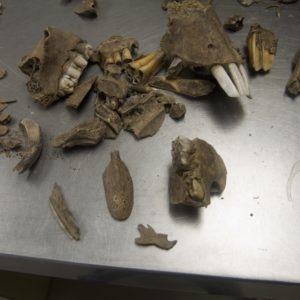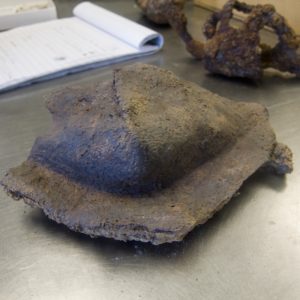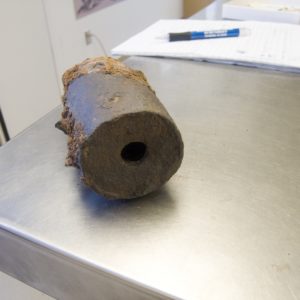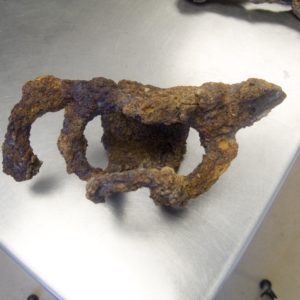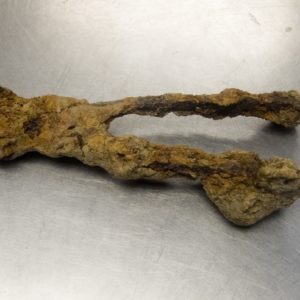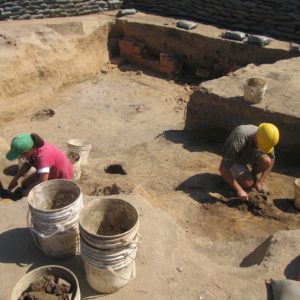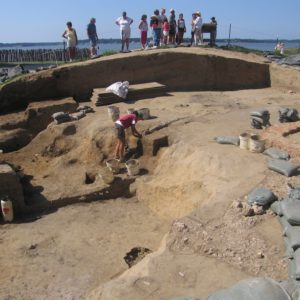All of the efforts of the Jamestown Rediscovery archaeologists are focused on the cellar of a fort-period building just inside the eastern palisade wall line. Excavations on the southwestern end of the cellar have revealed the presence of a set of earthen steps descending from the ground level above. An assortment of early-17th-century artifacts have been excavated from the cellar and more are sure to come as the archaeologists still have several feet of soil to remove before reaching the bottom.
In spite of temperature readings hovering near triple digits, the Jamestown Rediscovery archaeological team has been busy excavating a substantial fort-period cellar inside James Fort. The wall closest and parallel to the fort’s eastern palisade wall is partially brick-lined. The cellar’s northwestern wall has been found but it has no bricks. It is unknown if this wall was never brick-lined, or if its bricks were removed later for another construction project. Excavations at the southwestern end of the cellar have revealed a series of steps made out of soil that descend from the ground level above. Probing of the soil indicates that the bottom of the cellar is still several feet below the layer that the archaeologists are currently excavating.
Artifacts are steadily being discovered as excavations continue to give form to the cellar. A shot mold—a two handled tool used to create musket balls out of molten lead—was found in the cellar. This is just the latest in a series of shot molds that have been found by the Jamestown Rediscovery team over the years. A silver Elizabethan sixpence also turned up in the cellar. It dates to 1565 and has been nearly clipped in half. Clipping silver and gold coinage as a way of making change was commonly practiced during this time as coins were made to be worth their weight in the precious metals.
A large goffering iron excavated from the cellar is currently undergoing conservation. Much of the rust has been removed to reveal its bullet-like shape and a hole for a handle in one end. Goffering irons were heated and used with starch to shape sleeves and the large ruffed collars that were fashionable in the 16th and 17th centuries. A lockplate to a matchlock musket and a semi-swept hilt to a rapier, both dating to around 1600, were found during the cellar excavations. The front part of a peascod-type breastplate was also found in the cellar. Its conservation is nearing completion. These are the latest pieces to be added to the substantial collection of military artifacts in the Historic Jamestowne collection, highlights of which can be viewed in the Archaearium.
Thousands of animal bones discovered in the cellar give us more insight into the diet of the early settlers. Pig bones make up a large portion of the find, but remains of other animals also turned up, including a duck bill and the jaw of a small rodent—perhaps a rat.
One of the few gold objects found since the dig’s beginning in 1994 was just found in the cellar. This artifact is a puzzle ring made out of three interlocking circles and bearing the imprint of a heart. According to Jamestown Rediscovery Curator Bly Straube, the heart impression probably indicates that the ring was given as a sign of love or as a wedding ring.
Efforts will continue to focus on the cellar in the weeks ahead. Further excavations will hopefully give the archaeologists a more defined picture of the size and shape of the cellar. Many more artifacts are sure to turn up during the process.
related images
- Cellar steps to the right
- Gold puzzle ring
- Partially clipped 1565 Elizabethan sixpence
- Animal bones found in the cellar
- Front part of a peascod-type breastplate
- Goffering iron
- Matchlock musket lockplate
- Semi-swept rapier hilt
- Rusted shot mold
- Archaeologists at work in the cellar
- Mary Anna Richardson excavates an area near the southern end of the cellar





